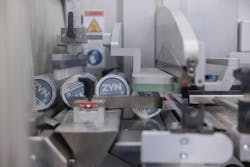So That Happened: Seriously Employers, Just Talk to Your People!
Editor’s note: Welcome to So That Happened, our editors’ takes on things going on in the manufacturing world that deserve some extra attention. This will appear regularly in the Member’s Only section of the site.
A Western Kentucky Plant Is Up to Snuff
Shall we add nicotine pouch manufacturing to the list of America’s manufacturing growth drivers?
The Kentucky commitment will create 450 jobs to go with the 1,100 people working there now. The investments will move the plant to a 24-hour, seven-days-per-week schedule from its five-day schedule today and, once complete next spring, give it a capacity of no fewer than 900 million cans annually. That’s more than 1,700 cans every minute.
Zyn products have grown into a key driver of growth for PMI, which acquired a majority of Swedish Match’s stock in late 2022 as part of a plan to evolve into a maker and marketer of smoke-free tobacco products. (Last year, that category accounted for more than 36% of the company’s more than $35 billion of revenues.) Early this year, the Zyn brand had a whopping 79% share of the U.S. nicotine pouch market thanks to having sold 443 million cans on a rolling 12-month basis, up 70% from a year earlier.
—Geert De Lombaerde
I Don't Know How to AI. Can AI Fix That?
The yearly tech trend narratives begin in late December/early January and then it’s a matter of when the hype begins to unravel. So it is with great interest that I read things like the Digital Work Trends report released by workforce management platform provider Slingshot, that states 77% of workers are lost on how to use AI.
Also, according to the report, employers implemented AI to assist with research for tasks and projects, manage workflows and analyze data, but nearly two-thirds of employees are instead using AI to double check their work.
The report lies this mismatch at the feet of inadequate training, that managers aren’t clearly communicating to employees what AI can accomplish. I’m more inclined to believe that employees just go with the flow, as the best use cases for AI in the workplace seem to revolve around report drafting, copy writing, and other text-based tasks.
Meanwhile, Deloitte’s recent “State of Generative AI in the Enterprise” report presents data that 79% of energy, resources and industrials (ER&I) companies have moved 30% or fewer of their GenAI experiments into production. Only 28% of ER&I leaders report that their organizations are tracking ROI on their GenAI deployments. Once imagines they’d pay more attention if the technology had the transformative potential we’ve been told it has.
The valid technology use cases come to light once the hype wheels spin off their axles. Those use cases aren’t as sexy as the marketing propositions but give us learnings to pass on that might actually improve everyone’s businesses. Hopefully we get there in 2025.
There’s also activity on the cybersecurity front. Halliburton on August 22 informed the SEC via Form 8-K filing that the oil giant was hit with a cyberattack, discovered the previous day, that forced system shutdowns earlier that week. No further details were disclosed other than standard declarations like having enacted its cybersecurity response plan and notified law enforcement and working to restore its systems and assess materiality.
—Dennis Scimeca
That Was Almost Really Bad
Many electric vehicles were damaged after a fire broke out in EV manufacturer Rivian’s Normal, Illinois, plant parking lot Saturday night, reported local news. The assembly plant itself, which manufactures all vehicles for the startup, was unharmed.
The fire was spotted just before 10 p.m. and was confirmed to be out as of midnight Sunday. No injuries have been reported, and Rivian is currently investigating the cause of the fire.
EV battery fires have been making headlines as electrification efforts continue to speed up in the U.S. Lithium-ion battery fires are difficult to extinguish and have the potential to reignite, stoking concerns among some consumers.
—Anna Smith
Battery Maker Says ‘Cash is King’ While Guarding its Horde
Not many start-ups can say they have zero debt with nearly 3 years’ worth of cash on hand. But that’s the position Freyr Battery finds itself in and the main theme of its second-quarter earnings call. The company, which aims to produce low-cost, state-of-the-art lithium-ion batteries, ended Q2 with $222 million in cash.
In a cash-is-king environment—and with Freyr not yet booking sales—controlling spend is important. While Freyr spent $31 million during the quarter, $8 million more than Q1, CFO Evan Calio attributed the increase to “non-recurring property deposits and [foreign exchange],” and that, after adjusting for those one-time expenses, spending was actually down $2 million quarter over quarter. YTD spending has come to $54 million.
If the trend continues, Freyr has just over two years of cash left. According to executives, though, they plan to stretch it for closer to three.
“In today's challenging financing environment, cash is king,” CEO Tom Jensen said. “Accordingly, we have built in flexibility in our operating model to adjust our cash burn rate to extend our runway to at least 36 months without raising any additional capital.”
Jensen, one of Freyr’s co-founders, is on his second round as the company’s CEO. He originally stepped aside in August 2023 but returned in June of this year when his successor, Birger Steen, abruptly stepped down. Since then, Freyr’s focus has been on building “a profitable business that generates first revenue and EBITDA as soon as [2025],” through its existing assets, which include two Giga factories.
Giga America is Freyr’s second facility being constructed in Coweta County, Georgia, and Giga Arctic is the existing facility in Norway, where Freyr is based, which Jensen said provided some “particularly interesting use cases” in regard to its ability to generate revenue for Freyr.
—Jennifer Ramsay
The Good and the Ugly of Product Recalls in Q2
In an early June So That Happened, I shared some distressing U.S. product recall numbers for the first quarter of 2024. The 909 recalls initiated across five key industries earned the three-month span an ugly record—that of the highest single-quarter product recall total in more than five years.
Thankfully, Q2 2024 paints a better picture, at least in terms of total product recalls. The number of recalls across the automotive, consumer product, food and drink, medical device and pharmaceutical sectors declined by 13.3% from the first quarter to land at 788.
Moreover, the total number of recalls dropped in each of the five sectors examined by brand protection company Sedgwick, which released the data in its latest U.S. Recall Index Report.
However, with the positive news comes the negative. While the total number of recalls dropped, the number of defective units in Q2 soared by 96.4% over the previous quarter, increasing to 254.6 million. Two of the five sectors accounted for the growth: In consumer products, the number of defective units jumped by 67.3% to 39.1million in Q2 2024. The data were even worse for medical devices, where the number of defective units (196.2 million) registered a 267.3% increase over the previous quarter.
The automotive, food and drink, and pharmaceutical sectors saw the number of defective units drop in the second quarter of 2024.
Sedgwick’s Chris Harvey, senior vice president of brand protection, suggested that strict regulatory scrutiny will continue. “Regulators are enforcing existing rules more stringently, while also working on or finalizing new rules that address emerging issues like AI,” Harvey said.
And because it never hurts to end on a high note, here is more good news. The first half of 2024 wins over the first half of 2023 by reporting fewer total recalls and fewer total defective units. The total number of recalls dropped just slightly, to 1,697 from 1,719, while the number of defective units dropped approximately 12%, to 384.2 million.
—Jill Jusko
Anna Karenina and Human Resources
Just as all happy families are the same, all HR people in all industries are highly concerned about recruiting the best talent. But HR people in different industries are unhappy in different ways. Which brings us to manufacturing.
Manufacturing’s workforce challenges are especially steep in several areas, says a just-released survey of 620 HR leaders by consulting firm Grant Thornton.
While 19% of HR leaders across all industries say retention is a challenge, a disproportionate 27% of respondents in manufacturing said the same.
How to improve retention? Take the time to get to know your shop-floor employees—who don’t typically have resumes, yet may have valuable hidden skills, suggests Joe Ranzau, Grant Thornton’s Growth Advisory Services managing director. Ranzau, in an article accompanying the study, told the story of a plant leader who found a way to communicate with a janitor who did not speak English (Google Translate, perhaps)?
Through their discussions, the supervisor learned the man had been an industrial engineer in Venezuela, and had plenty of ideas about how to improve operations. The janitor was promoted, and leadership saw the value in spending time engaging with employees.
Leadership development and employee engagement were also of higher concern in manufacturing compared to businesses overall. Ranzau observed that’s often because in manufacturing, “training” most often means developing technical skills, rather than building leaders.
Least among HR concerns in manufacturing? Total rewards costs and mental well-being of employees. No indication of whether that’s because these two areas are shipshape, or because manufacturers just care less about those things than other employers (we hope not!).
—Laura Putre
About the Author
Geert De Lombaerde
Senior Editor
A native of Belgium, Geert De Lombaerde has been in business journalism since the mid-1990s and writes about public companies, markets and economic trends for Endeavor Business Media publications, focusing on IndustryWeek, FleetOwner, Oil & Gas Journal, T&D World and Healthcare Innovation. He also curates the twice-monthly Market Moves Strategy newsletter that showcases Endeavor stories on strategy, leadership and investment and contributes to other Market Moves newsletters.
With a degree in journalism from the University of Missouri, he began his reporting career at the Business Courier in Cincinnati in 1997, initially covering retail and the courts before shifting to banking, insurance and investing. He later was managing editor and editor of the Nashville Business Journal before being named editor of the Nashville Post in early 2008. He led a team that helped grow the Post's online traffic more than fivefold before joining Endeavor in September 2021.
Dennis Scimeca
Dennis Scimeca is a veteran technology journalist with particular experience in vision system technology, machine learning/artificial intelligence, and augmented/mixed/virtual reality (XR), with bylines in consumer, developer, and B2B outlets.
At IndustryWeek, he covers the competitive advantages gained by manufacturers that deploy proven technologies. If you would like to share your story with IndustryWeek, please contact Dennis at [email protected].
Anna Smith
News Editor
News Editor
LinkedIn: https://www.linkedin.com/in/anna-m-smith/
Bio: Anna Smith joined IndustryWeek in 2021. She handles IW’s daily newsletters and breaking news of interest to the manufacturing industry. Anna was previously an editorial assistant at New Equipment Digest, Material Handling & Logistics and other publications.
Jill Jusko
Bio: Jill Jusko is executive editor for IndustryWeek. She has been writing about manufacturing operations leadership for more than 20 years. Her coverage spotlights companies that are in pursuit of world-class results in quality, productivity, cost and other benchmarks by implementing the latest continuous improvement and lean/Six-Sigma strategies. Jill also coordinates IndustryWeek’s Best Plants Awards Program, which annually salutes the leading manufacturing facilities in North America.
Have a story idea? Send it to [email protected].

Laura Putre
Senior Editor, IndustryWeek
As senior editor, Laura Putre works with IndustryWeek's editorial contributors and reports on leadership and the automotive industry as they relate to manufacturing. She joined IndustryWeek in 2015 as a staff writer covering workforce issues.
Prior to IndustryWeek, Laura reported on the healthcare industry and covered local news. She was the editor of the Chicago Journal and a staff writer for Cleveland Scene. Her national bylines include The Guardian, Slate, Pacific-Standard and The Root.
Laura was a National Press Foundation fellow in 2022.
Got a story idea? Reach out to Laura at [email protected]




